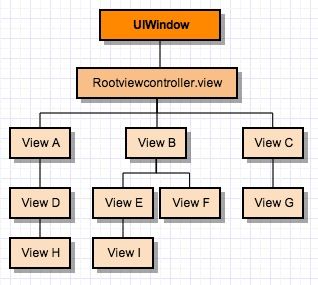一、iPhone机型适配
| 设备型号 | 屏幕尺寸 |
|---|---|
| iPhone 4/4S | 320 * 480 |
| iPhone 5/5C/5S | 320 * 568 |
| iPhone 6/6S/7 | 375 * 667 |
| iPhone 6Plus/6SPlus/7Plus | 414 * 736 |
二、mian()函数的作用
(1)创建了一个自动释放池。
(2)调用UIApplicationMain()函数。
(3)释放自动释放池。
main.m文件
#import
#import "AppDelegate.h"
//整个APP程序的主函数,入口函数
int main(int argc, char * argv[]) {
//自动内存释放池
@autoreleasepool {
//UIKit框架结构的启动函数
//参数1: argc 启动时带有参数的个数
//参数2: argv 参数列表
//参数3: nil 要求传入一个主框架类类名,如果参数为nil系统会用默认的框架类作为主框架类名
//参数4: 主框架的代理类对象名字
return UIApplicationMain(argc, argv, nil, NSStringFromClass([AppDelegate class]));
}
}
三、iOS应用的生命周期
iOS应用程序拥有的5种状态:
(1)Not running 应用还没启动或正在运行但是中途被系统停止
(2)Inactive 应用正在前台运行(不接收事件)
(3)Active 应用正在前台运行(接收事件)
(4)Background 应用处于后台运行(还在执行代码)
(5)Suspended 应用处于后台运行(停止执行代码)
#pragma //////////生命周期有关函数//////////
//应用将要进入非活动调用 (不接受消息或事件)
- (void)applicationWillResignActive:(UIApplication *)application;
//应用进入活动调用 (接收消息或事件)
- (void)applicationDidBecomeActive:(UIApplication *)application;
//应用进入后台调用 (设置后台继续运行)
- (void)applicationDidEnterBackground:(UIApplication *)application;
//应用将要进入前台调用
- (void)applicationWillEnterForeground:(UIApplication *)application;
//应用将要退出调用 (保存数据,退出前清理)
- (void)applicationWillTerminate:(UIApplication *)application;
//应用被终止前调用 (内存清理,方式应用被终止)
- (void)applicationDidReceiveMemoryWarning:(UIApplication *)application;
//应用载入后调用
- (BOOL)application:(UIApplication *)application didFinishLaunchingWithOptions:(NSDictionary *)launchOptions;
//应用打开URL时调用
- (BOOL)application:(UIApplication *)application handleOpenURL:(NSURL *)url;
四、UIViewController生命周期
(1)第一次访问UIViewController的view时,view为nil,然后就会调用loadView方法创建view,通过懒加载的方式进行加载。
(2)重写loadView方法,可以根据重写loadView方法创建View。
(3)View创建完毕后会调用viewDidLoad方法进行界面元素的初始化。
(4)StoryBoard加载的是控制器及控制器View。
(5)XIB加载的仅仅是控制器View。
#pragma //////////生命周期有关函数//////////
- (void)loadView; //加载视图资源并初始化视图(负责创建UIViewController的View)
- (void)viewDidLoad; //视图加载完毕(只执行一次,界面初始化操作,往View上添加子视图)
- (void)viewWillAppear:(BOOL)animated; //视图将要显示
- (void)viewDidAppear:(BOOL)animated; //视图显示
- (void)viewWillDisappear:(BOOL)animated; //视图将要消失
- (void)viewDidDisappear:(BOOL)animated; //视图消失
五、Cocoa中的类
#pragma -核心类
NSObject //根类 (所有类的根类,定义了所有类共有的方法,如alloc,init)
UIApplication //应用程序类 (应用运行期间的控制和协作工作)
[UIApplication sharedApplication]; //获取应用程序实例
UIWindow //窗口类 (管理和显示视图的容器)
UIView //视图类 (管理矩形区域内的所有屏幕显示)
#pragma -响应者链:
UIResponder //响应者类 (接收屏幕上的触摸事件)
- (void)touchesBegan: withEvent:; //触摸开始
- (void)touchesMoved: withEvent:; //触摸移动
- (void)touchesEnded: withEvent:; //触摸结束
- (void)touchesCancelled: withEvent:; //触摸取消
UIControl //控件类 (根据触摸事件触发操作)
UIViewController //视图控制器类 (管理视图的内容)
#pragma -数据类型类
NSString/NSMutableString //字符串
NSArray/NSMutableArray //数组
NSDictionary/NSMutableDictionary //字典
NSNumber/NSDecimalNumber //数字
NSDate //日期
NSURL //url
NSData //二进制
#pragma -UI界面类
UILabel //标签
UIButton //按钮
UISlider //滑块
UIStepper //步进
UIImage/UIImageView //图片
UISwitch //开关
UISegmentedControl //分段
UIWebView //网页
UIScrollView //滚动
UIPageControl //翻页
UIProgressView //进度
UIActivityIndicatorView //活动指示器
UITextField/UITextView //文本框
UIToolbar //工具栏
UIDatePicker/UIPickerView //选择器
UIColor //颜色
UITableView //列表
UICollectionView //网格
UIAlertController //选择控制器
UIPopoverController //弹框控制器
UINavigationController/UINavigationBar //导航控制器
UITabBarController/UITabBar //选项控制器
UISearchController/UISearchBar //搜索控制器
UIImagePickerController //图像选择控制器
六、响应者链
先向下找,再向上找的一个过程。
所有的iOS中关于的界面的类都直接或间接地继承与UIResponder。
(1)当用户点击某一个视图或者按钮的时候会首先响应application中UIWindow一层一层的向下查找,直到找到用户指定的view为止。(向下查找)
#pragma -查找用户点击的View
- (nullable UIView *)hitTest:(CGPoint)point withEvent:(nullable UIEvent *)event;
- (BOOL)pointInside:(CGPoint)point withEvent:(nullable UIEvent *)event;
(2)查看指定的View是否响应了点击事件,如果没有找它的nextResponder,再继续一层一层的向上查找,直到找到AppDelegate,再没有响应,则此点击事件被系统丢弃。(向上查找)
#pragma -查找用户点击的View响应事件
- (nullable UIResponder*)nextResponder;
七、空指针和野指针的区别
空指针: 没有存储任何内存地址的指针就称为空指针(NULL指针)。空指针就是被赋值为0的指针,在没有被具体初始化之前,其值为0。
野指针: 指向一个已删除的对象或未申请访问受限内存区域的指针。"野指针"不是NULL指针,是指向"垃圾"内存(不可用内存)的指针。野指针是非常危险的。
八、NSRunLoop
作用:
- 有事情的时候当前NSRunLoop的线程工作,没有事情做让当前NSRunLoop的线程休眠。
- 一直在循环检测,从线程开始到结束,检测同步事件。
- 系统已经在每条线程中加入RunLoop,主线程默认启动,子线程默认关闭,保证主线程在运行起来后就处于一种等待状态,如果有接收到事件就会执行任务,否则就会处于休眠状态。
- 每条线程都有唯一的一个RunLoop对象与之对应
- 保持程序的持续运行
- 处理APP中的各种事件(比如触摸,定时器,Selector)
- 节省CPU资源,提高程序性能,该做事时做事,该休息时休息
#pragma 系统默认注册运行模式RunLoop Mode(5个)
NSDefaultRunLoopMode: //默认的Mode,通常主线程的RunLoop是在这个Mode下运行。
UITrackingRunLoopMode: //界面跟踪Mode,当用户与界面交互的时候会在此Mode下运行。
NSRunLoopCommonModes: //这个不是一种真正的Mode,是一个占位用的Mode。
UIInitializationRunLoopMode: //程序启动时的Mode,启动完成后就不在此Mode下。
GSEventReceiveRunLoopMode: //接受系统事件的内部Mode,一般我们用不到。
#pragma RunLoop函数
[NSRunLoop mainRunLoop]; //获取主线程RunLoop对象
[NSRunLoop currentRunLoop]; //获取当前线程RunLoop对象
#pragma RunLoop应用
1)NSTimer
2)ImageView显示:控制方法在特定的模式下可用
3)PerformSelector
4)常驻线程:在子线程中开启一个runloop
5)自动释放池
第一次创建:进入runloop的时候
最后一次释放:runloop退出的时候
其它创建和释放:当runloop即将休眠的时候会把之前的自动释放池释放,然后重新创建一个新的释放池
(1)NSTimer应用
NSTimer受RunLoop Mode影响
//一、NSTimer默认添加到主线程中默认模式下工作----------------(NSDefaultRunLoopMode)
[NSTimer scheduledTimerWithTimeInterval:2 target:self selector:@selector(run) userInfo:nil repeats:YES];
//二、NSTimer只有在默认模式下工作-----------------------(NSDefaultRunLoopMode)
NSTimer *timer1 = [NSTimer timerWithTimeInterval:2 target:self selector:@selector(run) userInfo:nil repeats:YES];
[[NSRunLoop mainRunLoop] addTimer:timer1 forMode:NSDefaultRunLoopMode];
//三、NSTimer只有在拖拽UI界面模式下工作------------------(UITrackingRunLoopMode)
NSTimer *timer2 = [NSTimer timerWithTimeInterval:2 target:self selector:@selector(run) userInfo:nil repeats:YES];
[[NSRunLoop mainRunLoop] addTimer:timer2 forMode:UITrackingRunLoopMode];
//四、NSTimer只有在NSRunLoopCommonModes模式下工作-------(标记NSDefaultRunLoopMode/UITrackingRunLoopMode两种模式)
NSTimer *timer3 = [NSTimer timerWithTimeInterval:2 target:self selector:@selector(run) userInfo:nil repeats:YES];
[[NSRunLoop mainRunLoop] addTimer:timer3 forMode:UITrackingRunLoopMode];
RunLoop与GCD
CCD不受RunLoop Mode影响
(2)ImageView显示应用
//只在NSDefaultRunLoopMode下执行(刷新图片,拖拽UI不会刷新图片)
[_myImageView performSelector:@selector(setImage:) withObject:[UIImage imageNamed:@"1.jpg"] afterDelay:2.0 inModes:@[NSDefaultRunLoopMode]];
(3)常驻线程应用
#import "ViewController.h"
/*
思路:为了保证线程不死,我们考虑在子线程中加入RunLoop,
但是由于RunLoop中没有没有源,就会自动退出RunLoop,
所以我们要为子线程添加一个RunLoop,
并且为这个RunLoop添加源(保证RunLoop不退出)
*/
@interface ViewController ()
/** 线程对象 */
@property (nonatomic, strong)NSThread *thread;
@end
@implementation ViewController
- (void)viewDidLoad {
[super viewDidLoad];
// 创建子线程
self.thread = [[NSThread alloc] initWithTarget:self selector:@selector(run) object:nil];
//启动子线程
[self.thread start];
}
- (void)run {
NSLog(@"run--%@", [NSThread currentThread]); // 子线程
// 给子线程添加一个RunLoop,并且加入源
[[NSRunLoop currentRunLoop] addPort:[NSPort port] forMode:NSDefaultRunLoopMode];
// 启动RunLoop
[[NSRunLoop currentRunLoop] run];
NSLog(@"------------"); // RunLoop启动,这句没有执行的机会
}
- (void)touchesBegan:(NSSet *)touches withEvent:(UIEvent *)event {
// 在子线程中调用test方法,如果子线程还在就能够调用成功
[self performSelector:@selector(test) onThread:self.thread withObject:nil waitUntilDone:YES modes:@[NSDefaultRunLoopMode]];
}
- (void)test {
NSLog(@"test--%@", [NSThread currentThread]); // 子线程
}
@end
#pragma RunLoop监听活动枚举值
/* Run Loop Observer Activities */
typedef CF_OPTIONS(CFOptionFlags, CFRunLoopActivity) {
kCFRunLoopEntry = (1UL << 0), //状态值:1,表示进入RunLoop
kCFRunLoopBeforeTimers = (1UL << 1), //状态值:2,表示即将处理NSTimer
kCFRunLoopBeforeSources = (1UL << 2), //状态值:4,表示即将处理Sources
kCFRunLoopBeforeWaiting = (1UL << 5), //状态值:32,表示即将休眠
kCFRunLoopAfterWaiting = (1UL << 6), //状态值:64,表示从休眠中唤醒
kCFRunLoopExit = (1UL << 7), //状态值:128,表示退出RunLoop
kCFRunLoopAllActivities = 0x0FFFFFFFU //表示监听上面所有的状态
};
为主线程RunLoop添加观察者
#pragma 1.创建一个监听对象
/**
* 参数1: 告诉系统如何给Observer对象分配存储空间
* 参数2: 需要监听的类型
* 参数3: 是否需要重复监听
* 参数4: 优先级
* 参数5: 监听到对应的状态之后的回调
*/
CFRunLoopObserverRef observer = CFRunLoopObserverCreateWithHandler(CFAllocatorGetDefault(), kCFRunLoopAllActivities, YES, 0, ^(CFRunLoopObserverRef observer, CFRunLoopActivity activity) {
switch (activity) {
case kCFRunLoopEntry:
NSLog(@"进入RunLoop");
break;
case kCFRunLoopBeforeTimers:
NSLog(@"即将处理Timer");
break;
case kCFRunLoopBeforeSources:
NSLog(@"即将处理Source");
break;
case kCFRunLoopBeforeWaiting:
NSLog(@"即将休眠");
break;
case kCFRunLoopAfterWaiting:
NSLog(@"从休眠中唤醒");
break;
case kCFRunLoopExit:
NSLog(@"退出RunLoop");
break;
case kCFRunLoopAllActivities:
NSLog(@"监听上面所有状态");
break;
default:
break;
}
});
#pragma 2.给主线程的RunLoop添加监听
/**
* 参数1: 需要监听的RunLoop对象
* 参数2: 给指定的RunLoop对象添加的监听对象
* 参数3: 在哪种模式下监听
*/
CFRunLoopAddObserver(CFRunLoopGetCurrent(), observer, kCFRunLoopCommonModes);
#pragma 3.释放Observer
CFRelease(observer);
//输出: 从休眠中唤醒
//输出: 即将处理Timer
//输出: 即将处理Source
//输出: 即将处理Timer
//输出: 即将处理Source
//输出: 即将休眠
//输出: 从休眠中唤醒
//输出: 即将处理Timer
//输出: 即将处理Source
//输出: 即将休眠
//.....
九、沙盒机制
iOS8.3以后苹果禁止了对沙盒路径的访问
每个应用都只能访问当前沙盒目录下面的文件
- app 应用文件
- Documents 保存应用程序的数据文件。
- Library 保存默认设置或其它状态信息。
- Caches 保存缓存文件。
- Preferences 保存偏好设置文件,Plist文件。
- tmp 保存各种临时文件。
NSHomeDirectory() //获取沙盒目录
[[NSBundle mainBundle] bundlePath]; //获取沙盒目录.app文件
NSArray *paths = NSSearchPathForDirectoriesInDomains(NSDocumentDirectory, NSUserDomainMask, YES);
NSString *DocumentsPath = [paths objectAtIndex:0]; //获取沙河目录Documents文件夹
NSTemporaryDirectory() //获取沙河目录tmp文件夹
十、iOS数据存储
(1)Plist文件
(2)SQLite数据库
(3)CoreData数据库
SQLite数据库增删改查
支持类型:integer real, text, blob
使用单引号来环绕文本值。如果是数值,请不要使用引号。
#pragma 创建表
create table 表名 (字段1, 字段2, 字段3);
create table if not exists (字段1, 字段2, 字段3);
#pragma 插入
insert into 表名 (字段1, 字段2, 字段3) values (值1, 值2, 值3);
#pragma 更新
update 表名 set 字段1 = 值1, 字段2 = 值2, 字段3 = 值3;
update 表名 set 字段1 = 值2 where 字段1 = 值1;
#pragma 删除
delete from 表名
#pragma 查询
select * from 表名; //所有查询
select * from 表名 where 字段 = 值; //具体查询
select * from 表名 where 字段 like 值; //模糊查询
select * from 表名 order by 字段1 ASC, 字段2 DESC; //排序查询(ASC升序, DESC降序)
#pragma 统计
select count(*) from 表名;
select count(*) from 表名 where 字段 like 值;
select max(字段) from 表名;
select min(字段) from 表名;
select avg(字段) from 表名;
select sum(字段) from 表名;






